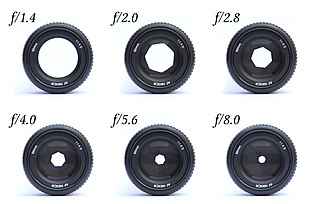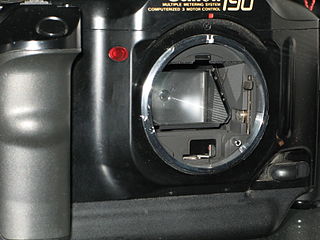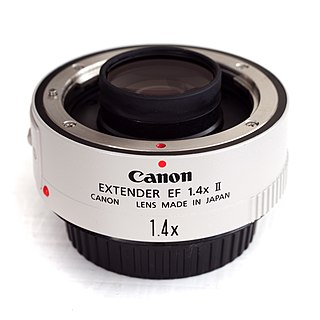
In optics, an aperture is a hole or an opening through which light travels. More specifically, the aperture and focal length of an optical system determine the cone angle of a bundle of rays that come to a focus in the image plane.

In photography, bokeh is the aesthetic quality of the blur produced in out-of-focus parts of an image, caused by Circles of Confusion. Bokeh has also been defined as "the way the lens renders out-of-focus points of light". Differences in lens aberrations and aperture shape cause very different bokeh effects. Some lens designs blur the image in a way that is pleasing to the eye, while others produce distracting or unpleasant blurring. Photographers may deliberately use a shallow focus technique to create images with prominent out-of-focus regions, accentuating their lens's bokeh.

The EF lens mount is the standard lens mount on the Canon EOS family of SLR film and digital cameras. EF stands for "Electro-Focus": automatic focusing on EF lenses is handled by a dedicated electric motor built into the lens. Mechanically, it is a bayonet-style mount, and all communication between camera and lens takes place through electrical contacts; there are no mechanical levers or plungers. The mount was first introduced in 1987.

The Canon FD lens mount is a physical standard for connecting a photographic lens to a 35mm single-lens reflex camera body. The standard was developed by Canon of Japan and was introduced in March 1971 with the Canon F-1 camera. It served as the Canon SLR interchangeable lens mounting system until the 1987 introduction of the Canon EOS series cameras, which use the newer EF lens mount. The FD mount lingered through the release of the 1990 Canon T60, the last camera introduced in the FD system, and the end of the Canon New F-1 product cycle in 1992.

The EF 70–200mm lenses are a group of telephoto zoom full-frame lenses made by Canon. The lenses have an EF mount to work with the EOS line of cameras.

The EF 1200 mm f/5.6 L USM is a super-telephoto prime lens that was made by Canon Inc. It uses an EF mount, and is compatible with the Canon EOS camera range. It has a focal length of 1200 mm and so on a digital body with a sensor size of 22.5 mm × 15 mm, such as a Canon EOS 40D or 450D, it provides a 35 mm field of view equivalent to that of a 1920 mm lens. With a body with a sensor size of 28.8 mm × 19.2 mm, such as a Canon EOS-1D Mark IV, the field of view is equivalent to that of a 1560 mm lens.

The EF 50mm lenses are a group of normal prime lenses made by Canon that share the same focal length. These lenses are based on the classic double-Gauss lens, with the f/1.8 being a standard six-element double-Gauss with an air gap and powers between element 2 and 3 and its faster cousins adding additional elements. The 50mm focal length, when used with a 35mm film or full-frame sensor, has been widely considered to match the perspective seen by the human eye.
The Canon EF 35mm lenses are a family of wide angle prime lenses with EF mount made by Canon Inc. The family also includes one EF-S lens that only mounts on Canon bodies with APS-C sensors.

Tilt–shift photography is the use of camera movements that change the orientation or position of the lens with respect to the film or image sensor on cameras.

The EF 85mm lenses are a group of medium telephoto prime lenses made by Canon Inc. that share the same focal length. These lenses have an EF type mount that fits the Canon EOS line of cameras.

Lens speed refers to the maximum aperture diameter, or minimum f-number, of a photographic lens. A lens with a larger than average maximum aperture is called a "fast lens" because it can achieve the same exposure as an average lens with a faster shutter speed. Conversely, a smaller maximum aperture is "slow" because it delivers less light intensity and requires a slower (longer) shutter speed.
The Canon EF 100 mm lenses are used for Canon DSLR cameras. There are four different types of EF 100 mm lens for Canon. Certain lenses are best for macro photos, whereas other lenses are good for taking pictures of subjects from a distance.

Originally produced by Minolta, and currently produced by Sony, the STF 135mm f/2.8 [T4.5] is a photographic lens compatible with cameras using the Minolta AF and Sony α A-mount. STF stands for Smooth Trans Focus, in reference to its special optical system, which is intended to smooth the transition between the plane of focus and out-of-focus areas in the image. This is accomplished by the use of an apodization filter that provides the high-quality bokeh effect. The lens is not a soft-focus lens.

The Canon Extender EF lenses are a group of teleconverter lenses made by Canon. These lenses are used between any compatible EF type lens and any of the Canon EOS line of cameras. When used with a compatible lens, they will multiply the focal length of the lens by a factor of either 1.4x or 2x, at the cost of decreasing the lens' aperture by 1 or 2 stops respectively. For example, using a 1.4x or 2x extender with the Canon EF 500mm f/4L IS USM would result in a 700mm f/5.6 or 1000mm f/8 lens.

The Fujifilm X-mount is a type of interchangeable lens mount designed by Fujifilm for use in those cameras in their X-series line that have interchangeable-lenses. These lenses are designed for 23.6mm x 15.6mm APS-C sensors.

The Canon Cinema EOS autofocus digital photographic and cinematographic SLR and mirrorless interchangeable lens camera system was introduced in late 2011 with the Canon EOS C300 and followed by the Canon EOS C500 and Canon EOS 1D C in early 2012.

The Pentax Q is a mirrorless interchangeable-lens camera introduced by Pentax on June 23, 2011.

The Sony FE 85mm F1.4 GM is a premium short telephoto full-frame prime lens for the Sony E-mount, released by Sony on February 3, 2016.

The Canon RF lens mount is an interchangeable-lens mount developed by Canon for its full-frame mirrorless interchangeable-lens cameras, and featured first by the EOS R, followed by the EOS RP. The RF mount was announced in September 2018. In May 2022, Canon announced APS-C EOS R cameras and RF-S lenses designed for these cameras.
















